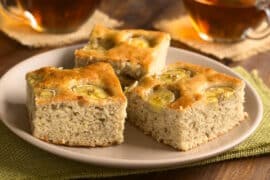If healthy eating and a healthy diet are important to you, then reading food labels is a must.
Food labels tell us a lot about a processed or prepared food.
They can help you understand the kinds of nutrients that are in the food, plus the amounts of those nutrients.
You will find information on the amount of saturated fat, sodium, fiber, carbohydrates and cholesterol found in the product.
Labels can be confusing and it can be difficult to understand how eating that food might affect your diet and overall health.
Here is some information about how to read food labels so you can make healthy food choices.
Serving Size
Serving size is the first detail you will see.
The amount of this particular food that is considered by the manufacturer to be the size of one serving is stated at the top of the label.
Read this section carefully as the suggested serving size can be far different than what you might consider a serving. Usually the suggested serving is smaller.
The label will provide you with information about the amount of calories per serving, but if they think a serving of cereal is 1/2 cup and you usually eat 1 cup or more, you are getting far more calories, fat and carbohydrates than you may think.
Read the serving size amount, determine if that is actually how much you eat of the product and calculate the actual calories consumed in the amount you eat. You may have to multiply by 2 or 3 to arrive at the actual number of calories, fat etc you would consume with your usual serving size of the product.
For example, if you usually eat an entire small pack of potato chips and the label says the package is equal to 3 servings, you have really consumed 3 times the calories, fat, salt and carbohydrates listed on the label as being in a serving. Yikes!
Nutrients
Food labels list the major nutrients found in the item. The nutritional claims are measured against the recommended daily dietary allowance of each nutrient. Usually, the nutritional amounts are based on a 2,000 calorie diet, but sometimes you will find information comparing it with a 2,500 calorie diet as well.
The stated % daily value on the food label indicates refers to how much of the nutrient is in one serving compared with the recommended daily dietary allowance for a 2,000 calorie diet.
If the label states that the product has the amount 20% listed next to fiber, that means that one serving of that product will give you 20% of the recommended intake of fiber for an average 2000 calorie a day healthy diet.
Ingredients List
The ingredients list on food labels contains a listing of the particular ingredients that were used to make the product. The list is usually arranged from largest weight to smallest, so if there is one cup of an ingredient in the product, it is listed before an ingredient that has a smaller weight. This simply means that one serving of the food includes the biggest quantity of the main ingredient (or the first item) and the minimum amount of the very last ingredient.
Healthy Recipes
Increase Metabolism
Lose Weight Without Feeling Hungry
Keys to a Healthy Lifestyle
Nutritional Claims on Food Labels
There are nutritional claims that companies can make about their products if they meet particular guidelines. For example, if a company wants to claim that a product is salt or sodium free, that product must contain less than 5 milligrams of sodium per serving.
Products labeled low sodium can have a maximum of 140 mg of sodium per serving and products that are “reduced in sodium” must have at least 25 percent less sodium than the regular product. A product labelled low fat must contain just 3 grams of fat or less.
These claims can help you decide whether or not that product meets your requirements for healthy eating.
Learning how to read food labels can seem tedious at first, but once you get the hang of it, they can tell you a lot about that product you are about to buy. Keep it in mind the next time you wonder if that packaged product really should be a part of your healthy diet.
Reading food labels is just part of maintaining a healthy lifestyle. You will find lots more information here.
Sign up here and be the first to get new recipes and tips.
If you like this page, please take a moment to share it on your favorite social media. You can add your comments below. Thanks a lot.











